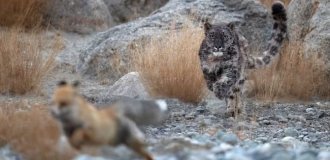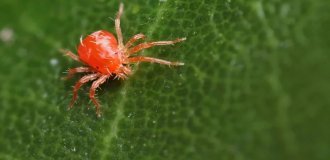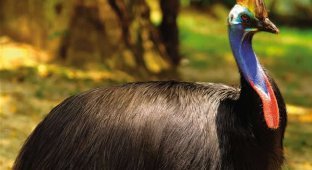There are many exotic animals on our planet that are not familiar to everyone. Their small numbers and narrow habitat mean that not even all residents of the country in which they live may know about the existence of these animals. This post will introduce you to the most exotic animals belonging to completely different species and classes.
Sumatran rhinoceros. The smallest of the family: the body length of an adult reaches 200–280 cm, and the height at the withers is 100–150 cm

Madagascar little arm (ouch). The only representative of the family of arms, a lateral branch of lemurs. Scary and charming

Tree kangaroos. They live in the highland tropical forests of Indonesia, Papua New Guinea and Australia. They are excellent climbers and can jump from one tree to another at a distance of 9 m

Moonfish. Can be more than 3 m long and weigh about 1.5 tons

Ant-eater

The Japanese giant salamander is the largest amphibian, which can reach 160 cm in length, weigh up to 180 kg and live up to 150 years.

Sulawesi bear couscous. A cute marsupial creature that lives in the treetops of the tropics and spends its time mostly sleeping

Sumatran rhinoceros

Laurie. A characteristic feature of this cutie is its large eyes, which can be bordered by dark circles. The face of a loris can be compared to a clown mask (in fact, loeris in translation means “clown”)

Muskrat. The second name is no less beautiful - Khokhulya. Popularly nicknamed the blind submariner. Indeed, it lives under water, its characteristics are most similar to a mole, and it does not see anything. By the way, it is endemic in the territory of the former USSR and is listed in the Red Book

Platypus. Its duck beak allows it to find food in the mud, like birds

The naked mole rat is a biological phenomenon: it is insensitive to pain, non-aggressive, and can be doused with acid or sprinkled with chili pepper without consequences. Lives ten times longer than any rodent and does not age. Society is structured like an anthill or a hive: with castes and the main female

Fish with a transparent head. She sees through it. It was discovered in 1939, but studied only in 2009, as it lives at great depths. Can only look up

Okapi, forest giraffe. At the beginning of the 20th century, the first explorers of the African continent mistook it for a small horse. Only after obtaining the skin and skull of the animal, scientists were able to discover that it was more similar to a dwarf giraffe from the Ice Age.

Manul is the main symbol of the Moscow Zoo

The capybara is the largest rodent in the world and the only representative of the capybara family. The weight of males can reach 65–70 kg

Belttail. Modern dragon. More precisely, a lizard

The gaptooth is a mammal from the order of insectivores. Small and dangerous because it is poisonous. Fortunately, the venom of the gaptooth kills only its victims, and can only cause some trouble to humans

Lilac frog. The jelly-like amphibian grows up to 9 cm, lives underground, feeding on termites, and only comes to the surface for a couple of weeks for dates.

Lamprey. Not a fish, but their predecessor from the class of cyclostomes. Endangered - too tasty

Sloth. Lives in trees, mimicking very successfully: real moss even grows in its fur!

Small red panda. Found only in mountain bamboo forests of the Chinese provinces of Yunnan and Sichuan, northern Burma, Bhutan, Nepal and northeast India

Hellish vampire, clam. Not an octopus, and not a squid, but a separate detachment - vampires

Mudskipper. Actually a fish, although it looks like a frog

The star-nosed insect is an insectivorous mammal of the mole family. It differs from other members of the family only in its characteristic stigma structure in the form of a rosette or star.

Sifaka is a monkey of the Indriidae family, Madagascar. A relatively new genus of primates, discovered only in 2004

Guidak is a large gastropod weighing up to 1.5 kg

Tarsier, order of primates. In their homeland, Indonesia, the local population was terribly afraid of them: of course, the pop-eyed monkeys could rotate their heads 360°. The Indonesians were afraid to encounter them, because they believed that the same thing could happen to people in this case

Tibetan fox. Found in Tibet, northwest India and northern Nepal at high altitudes

Fossa, endemic to the island of Madagascar. In appearance, it is something between a civet and a small puma. Fossa is sometimes called the Madagascar lion.

Isopod. Giant woodlice, approximately 30 cm long, live in the depths of the sea (about 1.6 km)

Maned wolf. Long legs are the result of evolution; they help the animal overcome obstacles in the form of tall grass growing on the South American plains

Tasmanian devil. It earned its nickname from the time of colonization, having strangled almost all the settlers’ chickens - although it is a marsupial, it is a predator!

The wombat is a marsupial that looks like a bear. It feeds on grass, digests it for up to 14 days and is the most economical consumer of water after the camel (22 ml of water per 1 kg of body weight per day). Fun fact: a city, an asteroid, a group and an anti-tank gun are named after wombats

Galago - the owner of a beautiful tail, the most numerous representative of primates in Africa

Fennec fox, desert fox

Gavial. Of course, one of the representatives of the crocodile order. Considered “kind” - never attacks people, muzzle is too narrow

Gavial























